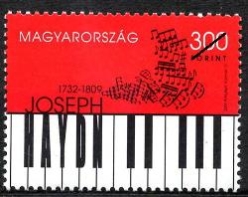HAYDN MEMORIAL YEAR 2009
Date of issue: 2 April 2009

Magyar Posta is commemorating the birth of the Austrian composer Joseph Haydn (Rohrau, 31 March 1732 – Vienna, 31 May 1809), the first great master of Viennese classical music, by issuing a special stamp.
Haydn’s musical talent became apparent very early in music-making
within the family. His parents, at no little financial sacrifice, had
the six-year old boy take music lessons, so he learnt how to write and
read music, played on instruments, and his singing improved. His chance
came when the choirmaster of Stephen’s Cathedral in Vienna, who was
looking for new choirboys, visited. Hearing the eight-year old child
sing, he accepted Haydn as a Cathedral chorister. His career there came
to an end when Haydn’s voice started to break. He then made a living
from copying scores, organ playing and teaching before turning to
composing.
Before long, Haydn went to Baron Fürnberg’s country home,
Weinzierl, where he composed his first string quartets. In 1759 he took
a position at Count Morzin’s estate in Bohemia, where his first
symphony was written. The young musician caught the attention of Prince
Paul Esterházy and he was appointed vice-Kapellmeister of the Eisenstadt
orchestra in 1761. The Prince died a year later and was followed by his
brother, Nikolaus Esterházy the Magnificent, who continued Haydn’s
employment. The composer wrote 170 pieces for the Prince, as well as
composing for others. When the Kapellmeister died, Haydn succeeded him
to the post. By 1766 the Esterházy palace in Fertőd was completed
together with the theatre and Music House, where the musicians lodged.
Their family members, however, remained in Eisenstadt, which probably
led to composing the well-known Farewell Symphony in 1722. In 1790
Nikolaus Esterházy died. His successor dismissed the orchestra and
theatre, but continued to pay the composer’s salary.
Haydn’s
reputation spread throughout Europe, and a few of his symphonies were
even performed in America. In 1791 he travelled to London, where he
composed new works. The concerts brought him enormous success and he
received an honorary doctorate in Oxford. Meanwhile Nikolaus Esterházy
II became the master at Eszterháza, who reorganised musical life on the
estate. Haydn was also given a role in this but this connection only
extended to writing a few new pieces. He died in 1809, and his ashes
were laid to rest in the former chapel of the Esterházy family, in the
Haydn Mausoleum in Eisenstadt’s Bergkirche. (Source:
http://hu.wikipedia.org/wiki/Joseph_Haydn)The stamp design is a witty graphic composition using
artistic licence to give a new function to the keys of a piano and the
notes, thus raising a memorial in an individual visual message on the
200th anniversary of the death of Joseph Haydn (1732-1809). An unusual
feature of the stamp issue is that every other row of stamps in the
sheet is inverted. The first day cover for the stamp depicts the lines
of the staff and the special postmark shows Joseph Haydn’s name and the
years of his birth and death.
SO
Order code: 2009080010011 (stamp) - 2009080060012 (FDC)
Date of issue: 2 April 2009
Printed by Állami Nyomda
Designed by Orsolya Kármán
Perforated size of stamps: 40 x 30 mm. There are 50 stamps in each sheet.
300,000 copies issued.
More information: philately@posta.hu

